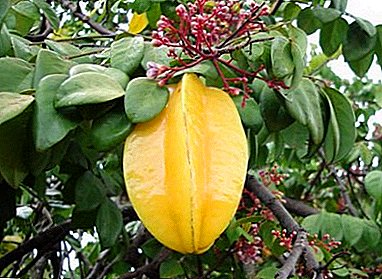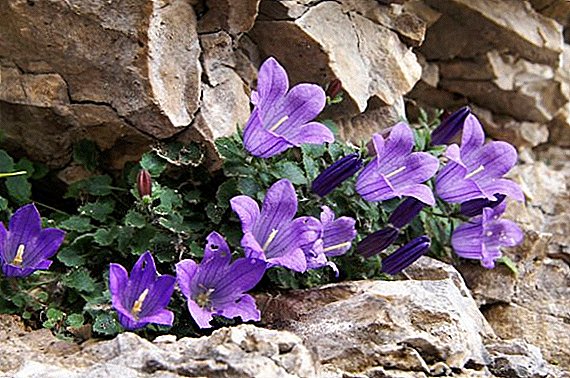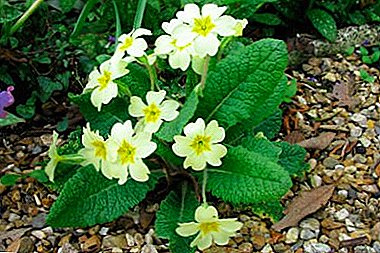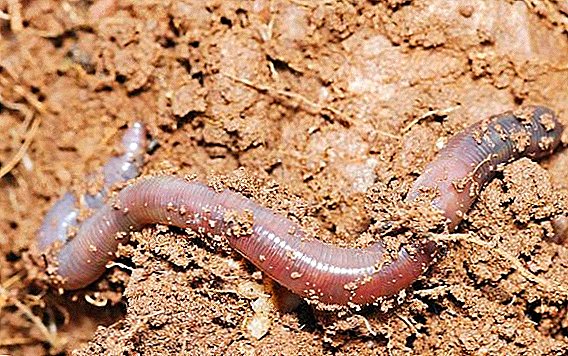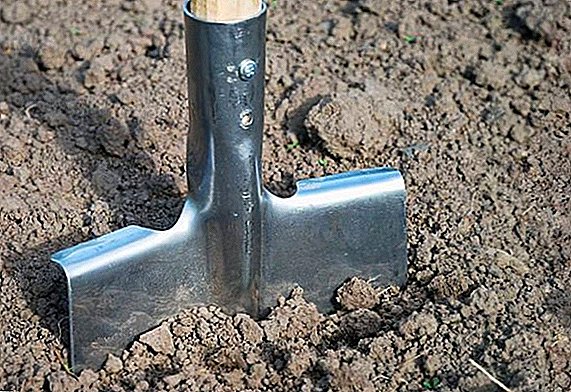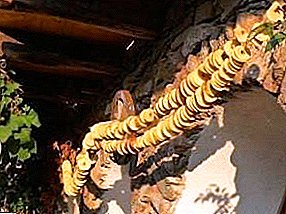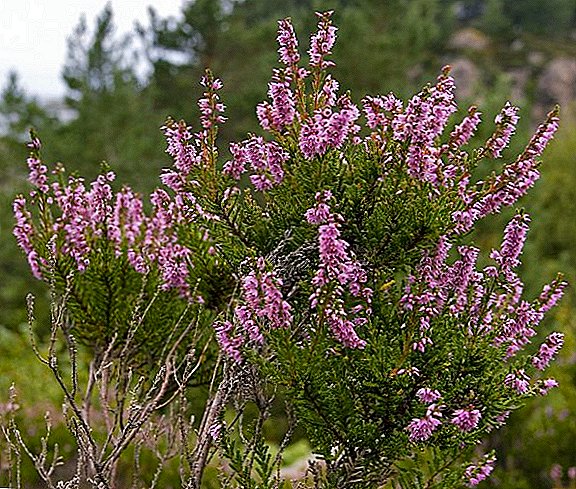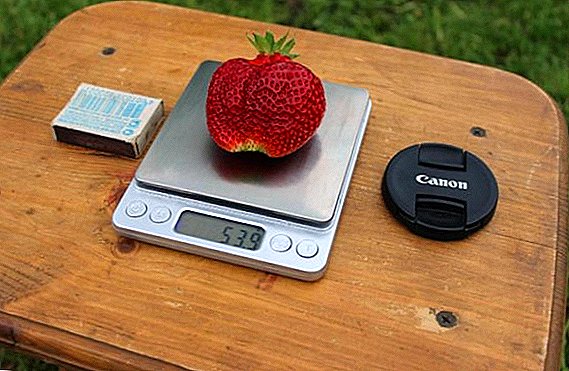 Large-fruited and at the same time easy-to-care strawberry is the dream of every summer resident. Someone just wants to feast on giant berries, grown with their own hands, while others are interested in them for commercial reasons. With such goals, saplings of hybrid varieties of European breeding are usually bought, among which there are also “champions”. Let's get acquainted with one of these lines - the variety of "Wima Zant".
Large-fruited and at the same time easy-to-care strawberry is the dream of every summer resident. Someone just wants to feast on giant berries, grown with their own hands, while others are interested in them for commercial reasons. With such goals, saplings of hybrid varieties of European breeding are usually bought, among which there are also “champions”. Let's get acquainted with one of these lines - the variety of "Wima Zant".
Variety description
This variety is considered a hybrid. - "Wima Zanta" appeared as a result of the selection of the lines "Elsanta" and "Crown", which predetermined the features of the hybrid.
In appearance, these are powerful and moderately spreading bushes with stems of medium height.
One of the features - light green leaves, folded in the shape of a boat.
The pubescent peduncles of moderate thickness are located at the level of the leaves and descend as the fruits ripen.

The mustache beats off actively, so there are no problems with reproduction.
Among other varieties "Wima Zanta" stands out with impressive fruit sizes, good drought resistance and moderate winter hardiness.
Find out what characteristics the Florence, Marmalade, Bereginya, Darselect, Vikoda, Zephyr, Roxana, Cardinal, Tristan, Black Prince, Mara de Bois grades have "," Alba "," Honey "," Clery "," Chamora Turusi "," Zenga Zengana "," Marshal "," Lord "," Russian Size ".
Those who grow this strawberry call these hybrid advantages:
- good yield;
- special taste of the berries, which favorably distinguishes them from the fruits of other giant lines;
- bushes do not "burn" in the sun and with normal care calmly tolerate drought (which is important for the southern regions);
- strong resistance to fusarium, gray mold, verticillus and other diseases;
- The intensive growth of the whiskers allows you to start breeding bushes for sale.
Important! When ordering planting material be sure to specify what you need exactly "Wima zanta"and not saplings of the "paternal" line "Elsanta" - There were cases when they were confused.
All this is good, but not without flaws, namely:
- the need for constant care (especially watering, with a long absence of which the berries become light and hollow from the inside);
- unimportant transportability - long transportation and frequent transfer to a new container deprive the fruit of their beautiful shape and taste;
- sensitivity to powdery mildew: if there is a large area of infection nearby, saving the bushes will be a very laborious task.

Summing up these facts, it turns out that this variety is more suitable for the owner of the summer cottage who sells products in nearby markets and has some experience with strawberries as such. Although the cultivation is actively engaged and beginners, who are attracted by massive fruit.
Characteristics of berries and yield
In addition to the outstanding size, these fruits are also remarkable bright red color without glossy overflow.
Over time, their shape changes: if the berries of the first harvest are similar to a practically regular ball, then in the future they become wide-conical, with a neck slightly flattened at both edges.
The flesh is very juicy and not very dense (although you can’t call it too soft).
But the main thing - the taste: rich, sweet and extraordinary, with a barely perceptible sourness.
Did you know? Strawberry is the only berry with seeds taken out.
In terms of yield, the variety is attributed to early ripe (and, more precisely, medium-early) lines. Fruiting occurs at the end of May - the beginning of June.

At this time, up to 600-800 g are removed from the bush (with an average weight of one berry of 40 g).
The peak yield is 2-3 years after planting, while the productive cycle is 4 years - after that the berries become noticeably shallow and lose their taste.
The yield directly depends on the place of cultivation and care: in the varietal characteristics, fees of 8-15 t / ha are mentioned. But practice shows that in our latitudes it is more correct to talk about the maximum figure of 8-10 t / ha (that is, 80-100 kg of berries are harvested from a well-groomed site with a "weave".
Agrotechnics of growing and caring for strawberries
These figures, coupled with a spectacular type of fruit fascinate many. But even before the purchase of planting material is familiar with the agrotechnics of the variety and the rules of care for the bushes line "Wima Zanta."
Learn how to grow strawberries using Finnish technology, Dutch technology.
Selection of seedlings
Healthy seedlings - the basis of the future harvest. To purchase really high-quality material, you should pay attention to such moments:
- the general condition of the seedling - flaccid copies disappear immediately;
- the number and integrity of the leaves - in healthy seedlings on the outlet should be at least 3 green leathery leaves without damage, spots and other violations;
- root collar sizes - if it is not less than 6-7 mm in diameter and without traces of rot or painful spots, then you have a healthy seedling;
- do not forget about the heart and lumpy roots - inspect them for the absence of rot and prisohlosti, and making sure that there are none, and the length of the open root exceeds 7 cm, you can safely buy such seedlings.

Important! Ordering seedlings through courier delivery services (this method is becoming increasingly popular) makes sense only in the warm season.By the way, about the roots. Bushes are often sold in peat pots. In this case, the roots must necessarily go outside. To finally verify their integrity, carefully lift the bush by the leaf stalks and remove it from the container. Verified sellers who sell quality products are unlikely to be against such a simple test.
Conditions of detention
Purchased seedlings need to prepare for planting. If spring planting is practiced, the first flower stalks are removed - this will allow the roots to get stronger faster, and the yield will be higher.
To young seedlings accustomed to the sun, they are hardened for several days - the capacity is taken out into the open air, in the shade.
Extremely important is the place for landing. The ideal location is an even and maximally lit place on the south or southwest side. Can be planted on an elevation, but only under the condition that there are no depressions and bumps.
Slopes and clay, lowlands and marshy areas are excluded (as well as shaded corners).
When selecting a place, take into account the fact that drip irrigation will have to be brought to the array allocated for bushes (that is, there should not be any obliques or other obstacles that complicate the ingress of moisture in the path of the tape).

Soil and fertilizer
"Vima Zanta" is readily accepted on light, well-moistened soils - the hybrid does not like poor soil. The greatest yields are removed from the bushes growing on light sandstones or sandy-loamy soil with a humus content of up to 3%.
The optimum acidity is 5-6 pH, so that alkaline soils also disappear.
Did you know? On the South-Ural railway there is a functioning station called Strawberry.
There is another nuance regarding the composition of the soil. The fact is that this variety does not tolerate the presence of excess carbonates in the earth (in other words, calcium by-products).
The depth of groundwater is also important - the horizon should be located at more than 1 m (a higher yield provokes rotting of the roots).
Well, if before that, on the site were grown the "right" crops, predecessors, - mustard and peas, radish and parsley.
Another important point - the timely laying of fertilizers.
If you plan to summer or autumn planting, it is carried out no later than a month before, at the same time with digging. Those who will carry saplings in the spring are recommended to take up such work in September.

When digging to the depth of a spade bayonet by 1 square. m future plantation contribute:
- 6-8 kg of compost or humus;
- 80 g (maximum 100 g) of superphosphate;
- 60 g of potassium salt;
- 50 g of nitrogen fertilizer.
Interesting technologies of growing curly strawberries, ampelous strawberries, in the beds of the pyramid, in the vertical beds, in hydroponics, in the greenhouse.
Watering and moisture
For a big harvest will require intensive watering. And preferably drip - bushes do not tolerate the abundant moisture on the green mass.
You can maintain the humidity by sprinkling the beds with mulch - for the best effect, this procedure is carried out immediately after planting.
Learn how to mulch strawberries.

Relation to temperature
We already know that such bushes tolerate heat well. As for the other temperature pole, breeders and sellers point out as much as a “life minimum” as much as -22 ° С.
Important! When grown in regions with stable and significant changes in winter temperature, the berries become more watery in taste.Of course, this is the lower limit, and the grown bushes will have to be sheltered from much smaller frosts, and snowless winters are not transferred in the best way (as well as frequent thaws with frosting).
Therefore, on the eve of the first frosts, the plantations are covered with a thick layer of fir spruce branches or pine needles, sawdust or straw. Foliage and old hay try not to use - they can spend winter pests.
A dense agrofibre that pulls on low arcs also helps - a good option for wintering in temperate climates. The main thing is that the coating does not touch the bush, otherwise it will freeze.
Shelters are in no hurry to take pictures in early spring - in addition to protection from repeated frosts, such a “hat” guarantees earlier fruiting (collection shifts by 7-10 days).

Reproduction and planting
Domestic gardeners usually practice two ways of breeding strawberries - transferring the rosette and dividing the whiskers. There is another option for obtaining new bushes from seeds, but due to labor intensity it is used extremely rarely.
The simplest scheme of transplanting sockets:
- From the mother plant cut off and dig out the socket of the first order.
- It is immediately, with the ground, transferred to a new hole, where fertilizer has already been laid and water has been poured. In this case, the remnants of the soil try not to shake.
- The first 2-3 days such a delenka will be lethargic in appearance, but then it will go away and the leaves will rise.
Did you know? In Belgium, in the city of Vépyon, a strawberry museum has been operating for a quarter of a century.

The method is simple, but quite traumatic for bushes, therefore Much more popular breeding whiskers:
- The mustache cut from the rosettes is placed in separate cups (by that time, a pinch of universal fertilizer with potassium, ammonia or phosphorus is already laid in the container with warm water).
- Within a few days, a socket will be formed that will take the first roots.
- Then it is transferred to a glass with a loose, dry substrate and for 5 consecutive days it is plentifully moistened (to the state of a swamp).
- After another 7-10 days, the top layer of the soil is dried, covered with mulch and prepared for shipment to open ground.
- After 45 days after the start of such work receive a separate bush.
Learn how to plant strawberries in spring and autumn, how to grow it from seeds.Suitable timeframes for full planting in open ground are:
- in the case of spring - April 15-May 5 (in the southern areas, you can start in the middle of March);
- in autumn - July 25-September 5 (or until the end of this month).

Important! Before planting, once again carefully inspect the bushes - they must be completely healthy.The scheme of the main landing in the open ground is quite simple:
- Holes 7–10 cm deep are dug out according to the 35 x 45 cm scheme (with a deficit of area they take 30 cm between the holes and 40 cm for the aisle, but not less, otherwise the whiskers will simply intertwine).
- 0.5 l of water is poured into each of them and some fertilizer is put in (manure and compost in equal parts with the addition of ash).
- The roots of seedlings are dipped in a soil talker, and then straightened and placed in holes, which are carefully sprinkled with soil (the heart must be at ground level).
- After the ground is tamped with the hands, it can be powdered with a layer of peat dust 2-3 cm.
Do not forget about the shelter, which will protect the bushes from possible frosts.
Video: autumn strawberry planting
Growing difficulties and recommendations
For most of our compatriots, this variety is still new, which sometimes causes difficulties in its content.
Some, having tried to grow these bushes, eventually refuse such an idea, citing the lack of taste in the berries. But we already know that the fruits of “Vima Zanta”, on the contrary, are very tasty, which means that the reason must be sought in violations of the technology of care.
The vast majority of such errors can be formulated as follows:
- wrong place selection;
- insufficient site preparation;
- lack of organic "bookmarks" when planting;
- misses when making seasonal supplements.
Did you know? Archaeologists claim that wild strawberries appeared in Europe during the Neolithic era (which is at least 5.5 thousand years ago).With the first three points, everything is clear, but working with fertilizers requires a separate description.

So, for spring application, with the goal of growing vegetative mass, use:
- calcium nitrate - 2 tbsp. l. / 10 l of water and 200 g under the bush will restore the necessary balance, for processing on the sheet only 1 tbsp is taken. l .;
- boric acid - 1 g on the same bucket, the foliage is sprayed with a spray;
- urea and ammonium nitrate - are taken strictly separately, 2 tbsp. l on 10 l, are brought on 200-250 g under a bush, after preliminary watering;
- the same volumes in the case of chicken manure or cow dung, however, the concentration is different - 1:20 or 1:10, respectively.
During maturation, fertilizers can and do not make. An exception is made for bushes growing on difficult soils or adjacent to vegetables. For their support are suitable:
- sheet feeding means - "Atlanta" (30-50 ml / 10 l of water) or the "Raykat Final" (25-30 ml for the same volume);
- root formulations - Calcinite (15–20 mg / 10 l) or Celik-K (50 ml).
Important! When buying chemicals and fertilizers, study the dosage and frequency of application - these data should be indicated on the package or in the package.
At the end of summer, furnace ash is introduced under the bushes and in the aisle at the rate of 1 kg / 1 sq. M. m. Many also use potassium sulfate (50 g / bucket and 250-300 ml under the bush). The main thing at this moment - do not use chloride compounds.

Learn what to do with reddening of leaves, verticillous and fusarium wilt, brown spot, nematodes, weevils on strawberries.
Pests, diseases and prevention
By itself, such a strawberry is considered resistant to major diseases and pests. But the neighborhood with other cultures can lead to the fact that without proper prevention and care, the bush "Vima Zanta" risks getting sick.
We list the most typical problems and methods for their solution:
- Gray rot. It manifests itself in shaded, overly dense and poorly ventilated beds. Spacing, light and loosening together with mulching will not give the fungus-causative agent any chance. Iodine (10 drops / 10 l of water, treated once a week) or mustard solution (50 g / 5 l of warm water with infusion of 2 days) are used as prophylactic agents. Teldor and Chorus are suitable from commercial products.
- Mealy dew. Spraying of the leaf with a weak (pale color) solution of potassium permanganate is intended to prevent its appearance. At the time of the appearance of peduncles, colloidal sulfur is also used: 50 g per bucket of a 10% solution of karbofos, with a double repetition of the treatment every other day.
- To combat spider mites, take a warm (over +30 ° C) solution of Carbofos - 3 tbsp. l./10 l of water. Plants are watered from a watering can with a nozzle-rain, tightly covering the plantation film for the next 3 hours.
- Newly purchased seedlings can be inhabited by inconspicuous mites. The easiest way to deal with them: seedlings for 10-15 minutes are immersed in water heated to +45 ° C.
- Night slugs, woodlice and snails will not enter the garden bed covered with mulch.
- You can repulse ants by watering the bushes with a simple solution (2 cups of vinegar and 1 cup of sunflower oil are added to 1 bucket of water).
- The most universal remedy is copper sulphate, which does not tolerate the majority of pests. Even before the appearance of the buds, it is mixed in equal parts with lime - it turns out Bordeaux mixture, which is applied to the leaves (but not more than 5 g per bucket).

Did you know? It is known for certain that the ancient Romans marinated sweet berries. But strawberries entered the culture through the efforts of the Moors, who in the Middle Ages settled on the Iberian Peninsula.As you can see, simple preventive measures help to protect strawberries from the majority of diseases and pests. In addition to spring treatments, it is important to clean weeds, control and timely replace mulch, remove diseased bushes, as well as old leaves - and then the protective effect will be much more noticeable.
Now you know what the Wima Zanta berry is, how attractive it is, and how to grow this miracle of breeding on your own plot. We hope this information will be useful to our readers and they will be able to surprise everyone with a record harvest of large berries. And let the hassle in the country will be only pleasant!
Strawberry Wima Zanta: reviews gardeners


Dignity - good winter hardiness, good taste.





